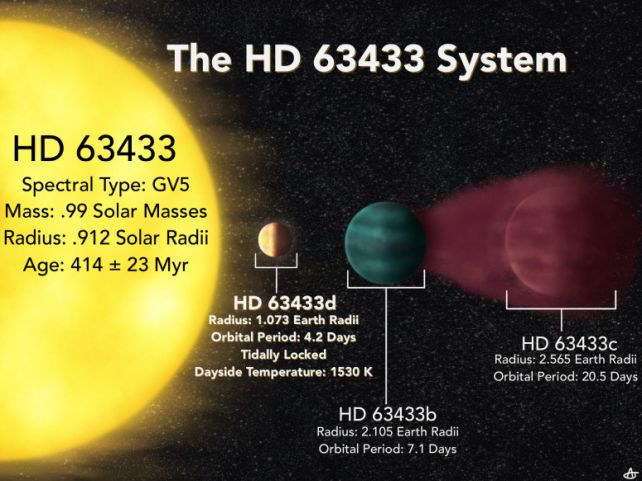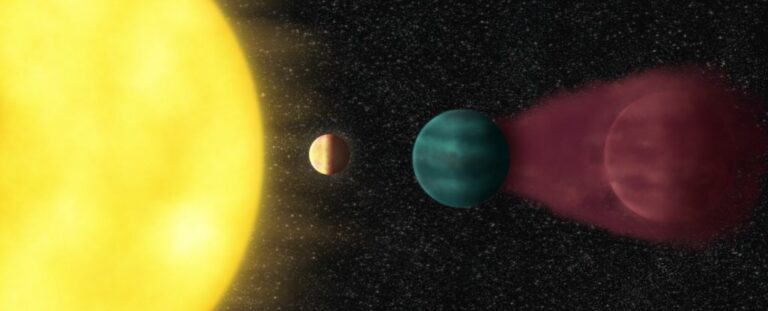Resembling Early Earth: Researchers Discover Planet Submerged in Molten Lava
A recently discovered exoplanet, located just 73 light-years away, provides a fascinating glimpse into what a young Earth might have been like if it had been situated in a tightly bound orbit with its star. This exoplanet, named HD 63433 d, is slightly larger than Earth and orbits a star similar to our Sun. It is the smallest planet found so far that is less than 500 million years old, offering a rare opportunity to study the formation of planets that share similarities with our own world, albeit with some notable differences.
Earth is currently the only known planet that supports life, making it crucial for scientists to understand the various ways in which Earth-like planets can form and evolve, particularly around stars similar to the Sun. This knowledge helps researchers identify the necessary ingredients for life to emerge elsewhere in the vast Universe.
HD 63433 d is both similar to and distinct from Earth, making it an incredibly valuable discovery. Its resemblance to an early Earth makes it a valuable resource for studying the evolution of terrestrial worlds, despite its close proximity to its star. By analyzing follow-up data, scientists can search for signs of outgassing and atmospheric loss, which could provide important insights into the development of planets like ours. However, the similarities between HD 63433 d and Earth end abruptly, as the exoplanet exhibits some remarkably extreme characteristics.
The University of Wisconsin-Madison’s astrophysicist, Melinda Soares-Furtado, and the University of Florida’s astronomer, Benjamin Capistrant, co-led the research on this intriguing exoplanet. Soares-Furtado describes HD 63433 d as a valuable planet due to its potential resemblance to an early Earth. Despite its close orbit, further investigations can shed light on the outgassing and atmospheric loss, which are crucial factors in understanding the evolution of terrestrial worlds. However, the differences between HD 63433 d and Earth are quite significant and captivating.
This Earth-sized exoplanet was discovered through a survey conducted using the TESS exoplanet-hunting telescope. The telescope observes stars, searching for regular, faint dips in starlight that indicate the presence of an orbiting exoplanet. By studying the effects of the exoplanet on the star’s light, astronomers can determine its size and mass.
HD 63433, a yellow dwarf star, bears a striking resemblance to our Sun in terms of size, mass, and temperature. However, it is significantly younger, with an age of slightly over 400 million years, in contrast to the Sun’s 4.5 billion years. In stellar chronology, HD 63433 is considered a mere infant, and this status extends to the exoplanets that encircle it. Currently, three exoplanets have been discovered in its vicinity – two mini-Neptunes, which were detected in 2020, and HD 63433 d.

Transit data reveals that HD 63433 d, an exoplanet, has a radius 1.1 times that of Earth. Although its mass is still unknown, its size strongly suggests a composition similar to terrestrial planets like Earth, Mars, or Venus.
This exoplanet orbits its star in an extremely tight orbit, completing one revolution every 4.2 days. Consequently, HD 63433 d and its star are in close proximity, potentially resulting in tidal locking, where one side of the planet always faces the star. Scientists speculate that due to this phenomenon, the hemisphere constantly exposed to the star experiences intense heat, causing its surface to likely be a permanent sea of molten rock. The dayside temperature is estimated to be around 1,570 Kelvin (1,297 Celsius or 2,366 Fahrenheit), resembling a vast lava ocean.
While Earth has never been as close to the Sun, it could have reached temperatures as high as 2,300 Kelvin during the collision that formed the Moon.
There is still much to learn about HD 63433 d, and further studies are anticipated to provide additional insights, including its mass. Determining its mass will enable scientists to calculate its density, shedding light on its composition. It may even be possible to ascertain the presence of an atmosphere and its composition.
Soares-Furtado expresses excitement about this exoplanet being in our solar neighborhood and the potential information it can provide. The proximity of this star, along with its crowded system, offers valuable opportunities for studying other planets among the approximately 100 similar stars in this young group.
HD 63433 d, the exoplanet nearest to Earth, possesses a radius similar to our own planet and revolves around a youthful star. There is still much to learn from this celestial body, and we eagerly anticipate uncovering further insights in the forthcoming months.
The research has been published in The Astronomical Journal.
Do not forget to share your opinion with us to provide you with the best posts !




0 Comments